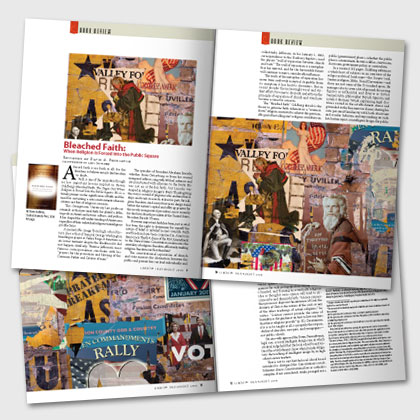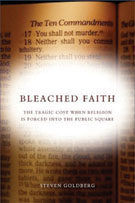Bleached Faith: When Religion Is Forced Into the Public Square
David A. Pendleton July/August 2009
A forced faith is no faith at all: for the freedom to believe entails the freedom to doubt.
Such is one of the unspoken though no less important lessons implicit in Steven Goldberg’s Bleached Faith: The Tragic Cost When Religion Is Forced Into the Public Square. His is a timely primer on the significance of faith and the need for sustaining a civic environment wherein citizens are free of religious coercion.
This Georgetown University law professor reminds us that personal faith has played a defining role in American history, culture, and politics. It has shaped the self-understanding of Americans, regardless of their individual religious/nonreligious predilections.
A memorable image from high school history class is that of General George Washington kneeling in prayer at Valley Forge. It functions as an iconic moment despite the likelihood it did not happen. Similarly, Thomas Jefferson’s most famous correspondence concludes with his “prayers for the protection and blessing of the Common Father and Creator of man.”
The speeches of President Abraham Lincoln, whether from Gettysburg or from his second inaugural address, ring with biblical cadences and are punctuated with allusions to the Deity. His was not an orthodox faith, but Lincoln was steeped in religious imagery. Every Thanksgiving the story is retold of pilgrims who endured hardships and trials in search, at least in part, for religious freedom. And every four years clergy stand before the nation’s capitol and offer up prayers for the newly inaugurated president, most recently for the forty-fourth president of the United States, President Barack Obama.

However important faith has been, just as vital has been the right to determine for oneself the nature of belief or unbelief in one’s own life. Faith and freedom have been conjoined in American democracy. The first clause of the First Amendment to the United States Constitution underscores the centrality of religious freedom, effectively making religious freedom our first freedom.1
The constitutional separation of church and state mirrors the distinction between the public and private lives we lead individually and collectively. Jefferson, in his January 1, 1802, correspondence to the Danbury Baptists, used the phrase “wall of separation between church and state.” The wall of separation is a metaphor that has exerted, and for the foreseeable future will continue to exert, considerable influence.
The truth of the metaphor of separation has never been uniformly accepted. Arguably, from its inception it has had its dissenters. But in recent decades the increasingly vocal and strident efforts by some to discredit and jettison the principle of separation of church and state have become a cause for concern.
The “bleached faith” Goldberg dreads is the threat to genuine faith inherent in a “watered-down” religion contrived to achieve the questionable goal of installing one’s religious worldview in public (government) places—whether the public place is a monument, historic edifice, courtroom, classroom, government policy, or curriculum.
In a succinct 161 pages, Goldberg references a whole host of subjects in an overview of the religio-political landscape—the Scopes trial, Santeria religion, Sikhs, Social Darwinism—and those are just some of the S’s touched upon. He manages also to cover a lot of ground: discussing figures as influential and diverse as Justice Samuel Alito, philosopher Baruch Spinoza, and novelist Herman Wouk; explaining legal doctrines rooted in the establishment clause and grounded in the free exercise clause; sharing his own personal familiarity with both observant and secular Judaism; and expounding on such hot-button topics as intelligent design, the public posting of the Ten Commandments, and Christmas and Chanukah displays on government property.
The book is not an autobiography, but it is in places profoundly personal. He writes not just as a detached and dispassionate legal scholar but as one well-versed in and appreciative of faith. “I am a Jew who is not very observant, yet I have a strong Jewish identity,” he divulges. “I have concluded . . . that religion can provide me with a sense of humility, faith, and values that science and secularism cannot” (pp. 5, 6).
Without being America-centric or anti-European, Goldberg submits that the uniquely American approach to faith in the public square avoids the perilous shoals upon which other ships of state have run aground: “We are neither France, where secularism reigns supreme, nor Iran, where one faith rules the roost. In France, students in public school cannot wear the Muslim head scarf; in Iran, they must. In America, the American Civil Liberties Union and the religious right agree that every public school student has a right to wear religious garb if and only if he or she so desires” (p. 5). American legal doctrine plots a course to steer clear of both a wholly secular society and a theocratic state.
That is not to say, however, that America is perfect. Alas, on too many occasions rancor, riot, and raucous clashes have erupted where peaceful religious coexistence should have prevailed. Is Goldberg’s account just a politically correct one? Or is he actually seeking the proverbial Aristotelian golden mean? I would contend, rather, that he is describing the constitutional balance gifted to us by the Founders.
One can imagine Goldberg taking criticism from both far right and far left—fundamentalists of the theistic and atheistic ilk. It should be apparent, however, that his “opposition to pushing religion into the courthouse and the biology classroom does not stem from hostility to religion,” for Goldberg is “opposed to bleached faith—the empty symbolism that diminishes the power of real belief” (p. 6).
A bleached or watered-down faith can occur, for example, when one seeks to situate in government buildings symbols of one’s religious beliefs —whether a cross, crèche, crescent moon, or Ten Commandments. While the government is not required to be silent with respect to its history, it is not the role of government to bestow its imprimatur on a given faith tradition. The USDA grades beef as “Prime,” “Choice,” or “Select,” but no government agency can so grade a religion. Goldberg points out how the Ten Command ments and their posting in government buildings is more about seeking the tacit approval of government than in educating citizens about the history of law. In seeking to make legal such postings, parties have watered down the very meaning of a singularly religious icon. This theme—of benevolent intentions being an insufficient safeguard against genuine harm—recurs throughout Bleached Faith.
On the topic of intelligent design and concerted efforts by some to inject creationism into the public school science curriculum, Goldberg warns against the serious untoward consequences for such pedagogical meddling. Science is limited, and framing an essentially religious idea as though it were science will tend to circumscribe and diminish faith. “Science can neither prove nor disprove the existence of God, the divinity of Christ, the nature of the soul, or any of the other teachings of actual religions,” he writes. “Science cannot provide the sense of humility or the guidance on how to live our lives that these religions provide” (p. 51). Creationism, if it is to be taught at all, is properly the responsibility of churches, mosques, and synagogues—not public schools.
He cites with approval the Dover, Pennsylvania, legal case, a recent intelligent design case, in which a federal judge held that the local school board violated the establishment clause when it made obligatory the teaching of intelligent design by its high school science teachers.
That is not to say that the local school board intended to disregard the Constitution’s establishment clause. Constitutional law as a whole is complex, if not convoluted. Multi-pronged tests, exceptions, nuances, and caveats abound, and the legal doctrine itself has unpredictably evolved over time. Witness the doctrinal progeny of Lemon v. Kurtzman2 and the on-again-off-again applicability of the Sherbert v. Verner compelling interest test.3
While a bright-line rule may not be easily discernible, it is nevertheless the responsibility of government actors not to cross that line. “Finding your way between the establishment and free exercise clauses is like walking a tightrope,” confesses Goldberg. “But it is a walk worth taking to preserve the unique brand of religious freedom we have in the United States” (p. 108). In important respects Bleached Faith is a clarion call for all Americans to acknowledge that the “unique . . . blend of free exercise and non-establishment—our insistence on avoiding both intolerant secularism and suffocating theocracy” (p. 128)— is worth the effort.
It is a not too subtle suggestion that when we visit the altars of our first freedoms we must return with the fire, not the ashes. Religious liberty depends as much on the voices of individual citizens as it does on the opinions of courts or the statutes of Congress, for the freedom to believe (or disbelieve) is too important to leave to government officials alone.
Goldberg ultimately describes himself as “someone who stands outside the camps of the resolutely secular and the resolutely religious,” for his camp can be seen as that of the resolutely constitutional. He invites all Americans to dedicate and consecrate themselves to the preservation of our first freedoms, for we are all heirs and therefore stewards of the liberty bequeathed to us.
- “Congress shall make no law respecting an establishment of religion, or prohibiting the free exercise thereof .”
- The Lemon test for doctrinal analysis of establishment clause violations consists of three prongs:
(1) The government’s action must have a secular legislative purpose;
(2) The government’s action must not have the primary effect of either advancing or inhibiting religion; and
(3) The government’s action must not result in an “excessive government entanglement” with religion.
If the law fails any of the three prongs, the government’s action is unconstitutional. Subsequent cases, however, have called into question the application of the Lemon three-pronged test. Most famously, former Supreme Court justice Sandra Day O’Connor advanced the endorsement test as a refinement of Lemon. - Sherbert v. Verner, 374 U.S. 398 (1963), signaled the high-water mark for free exercise clause protection of religious freedom. This case involved Ms. Adell Sherbert, a Seventh-day Adventist, and her fight for appropriate religious accommodation in the workplace. It mandated the compelling interest test in free exercise clause litigation. Subsequently, Employment Division v. Smith, 494 U.S. 872 (1990), limited the compelling interest test to free exercise cases wherein unemployment compensation was involved and permitted religious infringement by laws of general applicability. Then the compelling interest test was reinstated in 1993 by Congress’ passage of the Religious Freedom Restoration Act (RFRA), only to be curtailed thereafter by the Supreme Court in City of Boerne v. Flores, 521 U.S. 507 (1997), and Gonzales v. UDV, 546 U.S. 418 (2006).
Article Author: David A. Pendleton
David A. Pendleton has served as a schoolteacher, college instructor, trial lawyer elected state legislator, and policy advisor to a state governor, and now adjudicates workers' compensation appeals in Honolulu, Hawaii.